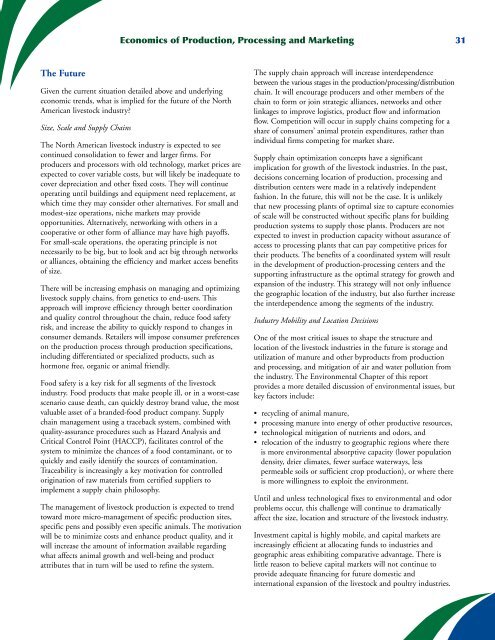The Future of Animal Agriculture in North America - Farm Foundation
The Future of Animal Agriculture in North America - Farm Foundation
The Future of Animal Agriculture in North America - Farm Foundation
Create successful ePaper yourself
Turn your PDF publications into a flip-book with our unique Google optimized e-Paper software.
<strong>The</strong> <strong>Future</strong><br />
Economics <strong>of</strong> Production, Process<strong>in</strong>g and Market<strong>in</strong>g 31<br />
Given the current situation detailed above and underly<strong>in</strong>g<br />
economic trends, what is implied for the future <strong>of</strong> the <strong>North</strong><br />
<strong>America</strong>n livestock <strong>in</strong>dustry?<br />
Size, Scale and Supply Cha<strong>in</strong>s<br />
<strong>The</strong> <strong>North</strong> <strong>America</strong>n livestock <strong>in</strong>dustry is expected to see<br />
cont<strong>in</strong>ued consolidation to fewer and larger firms. For<br />
producers and processors with old technology, market prices are<br />
expected to cover variable costs, but will likely be <strong>in</strong>adequate to<br />
cover depreciation and other fixed costs. <strong>The</strong>y will cont<strong>in</strong>ue<br />
operat<strong>in</strong>g until build<strong>in</strong>gs and equipment need replacement, at<br />
which time they may consider other alternatives. For small and<br />
modest-size operations, niche markets may provide<br />
opportunities. Alternatively, network<strong>in</strong>g with others <strong>in</strong> a<br />
cooperative or other form <strong>of</strong> alliance may have high pay<strong>of</strong>fs.<br />
For small-scale operations, the operat<strong>in</strong>g pr<strong>in</strong>ciple is not<br />
necessarily to be big, but to look and act big through networks<br />
or alliances, obta<strong>in</strong><strong>in</strong>g the efficiency and market access benefits<br />
<strong>of</strong> size.<br />
<strong>The</strong>re will be <strong>in</strong>creas<strong>in</strong>g emphasis on manag<strong>in</strong>g and optimiz<strong>in</strong>g<br />
livestock supply cha<strong>in</strong>s, from genetics to end-users. This<br />
approach will improve efficiency through better coord<strong>in</strong>ation<br />
and quality control throughout the cha<strong>in</strong>, reduce food safety<br />
risk, and <strong>in</strong>crease the ability to quickly respond to changes <strong>in</strong><br />
consumer demands. Retailers will impose consumer preferences<br />
on the production process through production specifications,<br />
<strong>in</strong>clud<strong>in</strong>g differentiated or specialized products, such as<br />
hormone free, organic or animal friendly.<br />
Food safety is a key risk for all segments <strong>of</strong> the livestock<br />
<strong>in</strong>dustry. Food products that make people ill, or <strong>in</strong> a worst-case<br />
scenario cause death, can quickly destroy brand value, the most<br />
valuable asset <strong>of</strong> a branded-food product company. Supply<br />
cha<strong>in</strong> management us<strong>in</strong>g a traceback system, comb<strong>in</strong>ed with<br />
quality-assurance procedures such as Hazard Analysis and<br />
Critical Control Po<strong>in</strong>t (HACCP), facilitates control <strong>of</strong> the<br />
system to m<strong>in</strong>imize the chances <strong>of</strong> a food contam<strong>in</strong>ant, or to<br />
quickly and easily identify the sources <strong>of</strong> contam<strong>in</strong>ation.<br />
Traceability is <strong>in</strong>creas<strong>in</strong>gly a key motivation for controlled<br />
orig<strong>in</strong>ation <strong>of</strong> raw materials from certified suppliers to<br />
implement a supply cha<strong>in</strong> philosophy.<br />
<strong>The</strong> management <strong>of</strong> livestock production is expected to trend<br />
toward more micro-management <strong>of</strong> specific production sites,<br />
specific pens and possibly even specific animals. <strong>The</strong> motivation<br />
will be to m<strong>in</strong>imize costs and enhance product quality, and it<br />
will <strong>in</strong>crease the amount <strong>of</strong> <strong>in</strong>formation available regard<strong>in</strong>g<br />
what affects animal growth and well-be<strong>in</strong>g and product<br />
attributes that <strong>in</strong> turn will be used to ref<strong>in</strong>e the system.<br />
<strong>The</strong> supply cha<strong>in</strong> approach will <strong>in</strong>crease <strong>in</strong>terdependence<br />
between the various stages <strong>in</strong> the production/process<strong>in</strong>g/distribution<br />
cha<strong>in</strong>. It will encourage producers and other members <strong>of</strong> the<br />
cha<strong>in</strong> to form or jo<strong>in</strong> strategic alliances, networks and other<br />
l<strong>in</strong>kages to improve logistics, product flow and <strong>in</strong>formation<br />
flow. Competition will occur <strong>in</strong> supply cha<strong>in</strong>s compet<strong>in</strong>g for a<br />
share <strong>of</strong> consumers’ animal prote<strong>in</strong> expenditures, rather than<br />
<strong>in</strong>dividual firms compet<strong>in</strong>g for market share.<br />
Supply cha<strong>in</strong> optimization concepts have a significant<br />
implication for growth <strong>of</strong> the livestock <strong>in</strong>dustries. In the past,<br />
decisions concern<strong>in</strong>g location <strong>of</strong> production, process<strong>in</strong>g and<br />
distribution centers were made <strong>in</strong> a relatively <strong>in</strong>dependent<br />
fashion. In the future, this will not be the case. It is unlikely<br />
that new process<strong>in</strong>g plants <strong>of</strong> optimal size to capture economies<br />
<strong>of</strong> scale will be constructed without specific plans for build<strong>in</strong>g<br />
production systems to supply those plants. Producers are not<br />
expected to <strong>in</strong>vest <strong>in</strong> production capacity without assurance <strong>of</strong><br />
access to process<strong>in</strong>g plants that can pay competitive prices for<br />
their products. <strong>The</strong> benefits <strong>of</strong> a coord<strong>in</strong>ated system will result<br />
<strong>in</strong> the development <strong>of</strong> production-process<strong>in</strong>g centers and the<br />
support<strong>in</strong>g <strong>in</strong>frastructure as the optimal strategy for growth and<br />
expansion <strong>of</strong> the <strong>in</strong>dustry. This strategy will not only <strong>in</strong>fluence<br />
the geographic location <strong>of</strong> the <strong>in</strong>dustry, but also further <strong>in</strong>crease<br />
the <strong>in</strong>terdependence among the segments <strong>of</strong> the <strong>in</strong>dustry.<br />
Industry Mobility and Location Decisions<br />
One <strong>of</strong> the most critical issues to shape the structure and<br />
location <strong>of</strong> the livestock <strong>in</strong>dustries <strong>in</strong> the future is storage and<br />
utilization <strong>of</strong> manure and other byproducts from production<br />
and process<strong>in</strong>g, and mitigation <strong>of</strong> air and water pollution from<br />
the <strong>in</strong>dustry. <strong>The</strong> Environmental Chapter <strong>of</strong> this report<br />
provides a more detailed discussion <strong>of</strong> environmental issues, but<br />
key factors <strong>in</strong>clude:<br />
• recycl<strong>in</strong>g <strong>of</strong> animal manure,<br />
• process<strong>in</strong>g manure <strong>in</strong>to energy <strong>of</strong> other productive resources,<br />
• technological mitigation <strong>of</strong> nutrients and odors, and<br />
• relocation <strong>of</strong> the <strong>in</strong>dustry to geographic regions where there<br />
is more environmental absorptive capacity (lower population<br />
density, drier climates, fewer surface waterways, less<br />
permeable soils or sufficient crop production), or where there<br />
is more will<strong>in</strong>gness to exploit the environment.<br />
Until and unless technological fixes to environmental and odor<br />
problems occur, this challenge will cont<strong>in</strong>ue to dramatically<br />
affect the size, location and structure <strong>of</strong> the livestock <strong>in</strong>dustry.<br />
Investment capital is highly mobile, and capital markets are<br />
<strong>in</strong>creas<strong>in</strong>gly efficient at allocat<strong>in</strong>g funds to <strong>in</strong>dustries and<br />
geographic areas exhibit<strong>in</strong>g comparative advantage. <strong>The</strong>re is<br />
little reason to believe capital markets will not cont<strong>in</strong>ue to<br />
provide adequate f<strong>in</strong>anc<strong>in</strong>g for future domestic and<br />
<strong>in</strong>ternational expansion <strong>of</strong> the livestock and poultry <strong>in</strong>dustries.

















